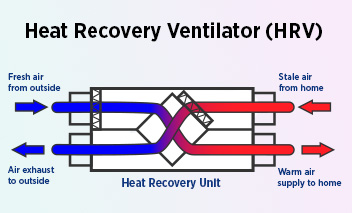The All-Inclusive Guide to the Uses of Heat Recovery Ventilation in Modern Structures
Heat Recovery Ventilation (HRV) systems stand for a considerable improvement in developing modern technology (HRV Heat Recovery Ventilation). They provide an approach for trading stale interior air with fresh outdoor air while reducing power loss. This strategy not just improves interior air quality but additionally adds to power effectiveness in both household and industrial buildings. Recognizing the various applications and benefits of HRV can expose its crucial function in modern-day design and sustainability initiatives. The ramifications of this modern technology deserve exploring further
Comprehending Heat Recovery Ventilation Equipments

Although lots of modern structures prioritize energy efficiency, understanding heat healing ventilation (HRV) systems is crucial for optimizing interior air quality and reducing energy usage. HRV systems work by transferring warm from stale indoor air to incoming fresh air, efficiently keeping comfortable interior temperatures while minimizing energy loss. These systems consist of a warm exchanger, followers, and ductwork that assist in the blood circulation of air. During wintertime, HRV devices catch and reuse heat from the outward bound air, while in summertime, they can help cool down incoming air. By constantly exchanging air, HRV systems likewise decrease moisture and the concentration of indoor pollutants. Appropriate installation and maintenance of HRV systems are important for their effectiveness and effectiveness in improving total building performance and comfort.
Benefits of Heat Recovery Ventilation
Heat recovery ventilation systems supply various advantages that enhance both energy performance and interior air quality in modern-day buildings. By recording and recycling energy from exhaust air, these systems considerably reduce home heating and cooling expenses, resulting in reduced energy consumption. They keep a stable flow of fresh exterior air, decreasing the danger of interior air pollutants and irritants. This continuous exchange aids manage humidity levels, preventing mold and mildew development and guaranteeing a much healthier living environment. Furthermore, HRV systems contribute to sustainability goals by reducing total carbon footprints. Their ability to maximize air flow without giving up thermal convenience makes them a beneficial enhancement to contemporary building layout, promoting both economic and environmental advantages.
Applications of HRV in Residential Structures
As house owners significantly prioritize energy efficiency and indoor air high quality, the applications of heat recuperation air flow (HRV) systems in domestic structures have become extra widespread. HRV systems are specifically useful in tightly sealed homes, where preserving fresh air blood circulation is vital for protecting like this against moisture buildup and indoor contaminants. They efficiently move warmth from outgoing stagnant air to inbound fresh air, decreasing energy expenses associated with heating & cooling. In addition, HRVs can improve convenience levels by regulating humidity and temperature level. They are additionally versatile for different residential styles, including single-family homes and multi-unit structures. In general, integrating HRV systems supports lasting living methods while guaranteeing a much healthier indoor environment for residents.
HRV in Industrial and Commercial Settings
In commercial and commercial settings, the implementation of warmth recovery air flow (HRV) systems has actually ended up being significantly critical for maximizing power performance and preserving air top quality. These systems efficiently move heat from exhaust air to inbound fresh air, reducing the need for additional home heating or air conditioning. This not just lowers power costs yet also adds to sustainability efforts. Industries such as production, warehousing, and workplace structures benefit greatly from HRV systems, as they assist control temperature and moisture levels, making sure a comfortable and productive environment. Furthermore, HRV systems help in eliminating impurities and excess dampness, boosting interior air quality. As guidelines around air quality end up being more stringent, the adoption of HRV modern technology is most likely to grow, making it an essential element of modern-day commercial and industrial framework.
Future Patterns in Heat Recovery Ventilation Modern Technology

Often Asked Concerns
Just How Does Heat Recovery Ventilation Influence Indoor Air Quality?
Heat recovery ventilation considerably enhances interior air quality by continuously exchanging stale indoor air with fresh exterior air while recovering power. This process decreases contaminants, keeps ideal humidity degrees, and ensures a much healthier atmosphere for owners.
Can HRV Systems Be Mounted in Existing Buildings?
HRV systems can indeed be set up in existing buildings. Retrofitting might call for modifications to ductwork and air flow formats, but it substantially enhances energy performance and indoor air top quality, making it a viable alternative for older frameworks.
What Maintenance Is Needed for HRV Systems?

Exist Certain Climates Where HRV Is Extra Reliable?
Heat recovery ventilation systems are especially efficient in climates with substantial temperature level distinctions in between seasons. These systems enhance energy performance by recouping warmth from exhaust air, making them perfect for both chilly and reasonably warm atmospheres.
Exactly How Do HRV Systems Affect Energy Costs?
